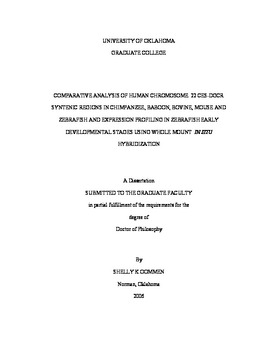| dc.contributor.advisor | Roe, Bruce A., | en_US |
| dc.contributor.author | Oommen, Shelly K. | en_US |
| dc.date.accessioned | 2013-08-16T12:20:04Z | |
| dc.date.available | 2013-08-16T12:20:04Z | |
| dc.date.issued | 2006 | en_US |
| dc.identifier.uri | https://hdl.handle.net/11244/993 | |
| dc.description.abstract | The final series of experiments were based on the earlier observation that 16 genes in the human chromosome 22 CES-DGCR region had reported expression but no detailed expression profiles while 6 others had no known expression profiles. Through the comparative sequencing and subsequent whole mount in situ studies reported in this dissertation, expression of these 22 genes was observed to occur during zebrafish development, mainly during early developmental stages followed by either decreased or no expression in later stages in the brain, ear, eyes, heart, pharyngeal arches, liver, and kidney, all organs related to anomalies resulting in phenotype observed in CES-DGCR patients. Therefore, the third major conclusions from this present work is that contrary to prior studies pointing to single gene alterations resulting in these diseases, it now is clear that both CES and DGCR are multigene-based diseases.* | en_US |
| dc.description.abstract | *This dissertation is a compound document (contains both a paper copy and a CD as part of the dissertation). The CD requires the following system requirements: Adobe Acrobat. | en_US |
| dc.description.abstract | The majority of the amino acid substitutions in humans, chimpanzees, baboons and bovines are changes from hydrophilic to hydrophilic amino acids. The observed human and chimpanzee substitution rate was 1.2% and that between humans and baboons was 2.6%, with Ka/Ks ratios for human and chimpanzee at 0.44 and human and baboon at 0.48. Thus, the second major conclusion from this present work is that at least in the case of humans vs. primates, the genes are evolving by purifying selection. | en_US |
| dc.description.abstract | Comparative genomic analysis is a powerful tool that can illuminate the genomic sequence features that result in the changes that drive evolution. In this dissertation, the 4.5 Mb region proximal to the centromere of human chromosome 22 that encodes the contiguous Cat Eye Syndrome and DiGeorge-Velocardiofacial Syndrome (CES-DGCR/VCFS) Critical Regions and the orthologous regions from chimpanzee, baboon, cow, mice and zebrafish have been sequenced and compared. Overall the human and chimpanzee sequences were ∼ 98.5% identical and the human-baboon sequences were ∼ 92% identical at the nucleotide level. A high degree of conservation was observed in both the gene order and the coding region sequences for these synteny regions, with a lower degree of conservation in the intronic and intergenic regions. The conserved structural features likely represent conserved functional properties while the observed differences must be responsible for portions of the human and primate specific phenotypes. The region studied was slightly larger in humans than in chimpanzees and baboons, since the human lineage had a higher insertion frequency relative to the other primates (or the other primates have a higher deletion frequency compared to humans). By comparing the sequenced regions of the chimpanzee genome from three different individual chimpanzees, Clint (ch251), Donald (rp43) and Gon (ptb), the first major conclusion from this dissertation research is that these three chimpanzees differ from each other by ∼ 1.2%, almost as much as humans differ from chimpanzees. | en_US |
| dc.format.extent | xv, 374 leaves : | en_US |
| dc.subject | Chromosomes Analysis. | en_US |
| dc.subject | Chemistry, Biochemistry. | en_US |
| dc.subject | In situ hybridization. | en_US |
| dc.subject | Biology, Genetics. | en_US |
| dc.subject | Comparative genomic hybridization. | en_US |
| dc.subject | Gene expression. | en_US |
| dc.title | Comparative analysis of human chromosome 22 CES-DGCR syntenic regions in chimpanzee, baboon, bovine, mouse and zebrafish and expression profiling in zebrafish early developmental stages using whole mount in situ hybridization. | en_US |
| dc.type | Thesis | en_US |
| dc.thesis.degree | Ph.D. | en_US |
| dc.thesis.degreeDiscipline | Department of Chemistry and Biochemistry | en_US |
| dc.note | Adviser: Bruce A. Roe. | en_US |
| dc.note | Includes supplementary digital materials. | en_US |
| dc.note | Source: Dissertation Abstracts International, Volume: 67-02, Section: B, page: 0875. | en_US |
| ou.identifier | (UMI)AAI3207532 | en_US |
| ou.group | College of Arts and Sciences::Department of Chemistry and Biochemistry | |
